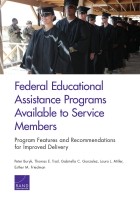| 来源类型 | Research Reports
|
| 规范类型 | 报告
|
| ISBN | 9780833088192
|
| 来源ID | RR-664-OSD
|
| Federal Educational Assistance Programs Available to Service Members: Program Features and Recommendations for Improved Delivery |
| Peter Buryk; Thomas E. Trail; Gabriella C. Gonzalez; Laura L. Miller; Esther M. Friedman
|
| 发表日期 | 2015
|
| 出版年 | 2015
|
| 页码 | 86
|
| 语种 | 英语
|
| 结论 |
Civilian Educational Assistance Programs Are Prevalent and a Large Investment in the United States - Few companies, however, investigate the impacts of such programs.
Limited Evidence Exists on the Impact of Military Educational Assistance Programs - The desired impacts of Department of Defense (DoD) educational assistance programs include improved recruitment, readiness, and retention and successful transition to civilian life.
- Some research suggests that the availability of military educational assistance attracts higher-quality recruits.
- Other research suggests that, while this is so, assistance recipients may leave service earlier than others.
- It is unclear whether the net result is positive or negative.
Federal Educational Assistance Programs Offer Service Members Multiple Pathways to Obtaining College Degrees - Other potential outcomes include additional military training and occupational licenses and certificates.
- College credit can be obtained by taking standardized tests, utilizing programs that recommend college credit for military experience, and completing college courses.
- Ideally, educational assistance enhances the professional advancement of program participants.
Many of the Programs Overlap, Especially for Active-Duty Personnel - Eligibility for DoD and Department of Veterans Affairs benefits is frequently linked to active duty status, resulting in fluctuating options for reserve component members.
- Not all combinations of assistance are helpful in the long run; for instance, some might tap into GI Bill benefits at a time when other funding sources are available, reducing the only funding that will still be available postservice.
- Service members must navigate disparate sources to gather information on the education benefits available to them at various times during their military careers.
|
| 摘要 |
- Programs already collect and analyze data on outputs but need to do more to track and assess intended goals and outcomes (e.g., enrollment rates, persistence rates, or graduation rates).
- Guide service members who are students to use Department of Defense (DoD) programs that generate transferrable academic credit through testing and conversion of work experience whenever possible to reduce the costs of DoD and Department of Veterans Affairs programs that provide direct funding for education. These programs are less expensive than the cost of tuition and fees for equivalent credits.
- Create an integrated online federal educational assistance system to help service members design a time-efficient education plan that would make the best use of the benefits for which they qualify. An integrated system could also help reduce overall costs by providing program managers the tools they need to identify possibly redundant or inefficient program spending across the programs and departments.
|
| 主题 | Continuing Education
; Human Capital Investments
; Military Education and Training
; Postsecondary Education
; Workforce Management
|
| URL | https://www.rand.org/pubs/research_reports/RR664.html
|
| 来源智库 | RAND Corporation (United States)
|
| 资源类型 | 智库出版物
|
| 条目标识符 | http://119.78.100.153/handle/2XGU8XDN/108037
|
推荐引用方式
GB/T 7714 |
Peter Buryk,Thomas E. Trail,Gabriella C. Gonzalez,et al. Federal Educational Assistance Programs Available to Service Members: Program Features and Recommendations for Improved Delivery. 2015.
|
|
文件名:
|
x1495316281106.jpg
|
|
格式:
|
JPEG
|

|
文件名:
|
RAND_RR664.pdf
|
|
格式:
|
Adobe PDF
|
除非特别说明,本系统中所有内容都受版权保护,并保留所有权利。